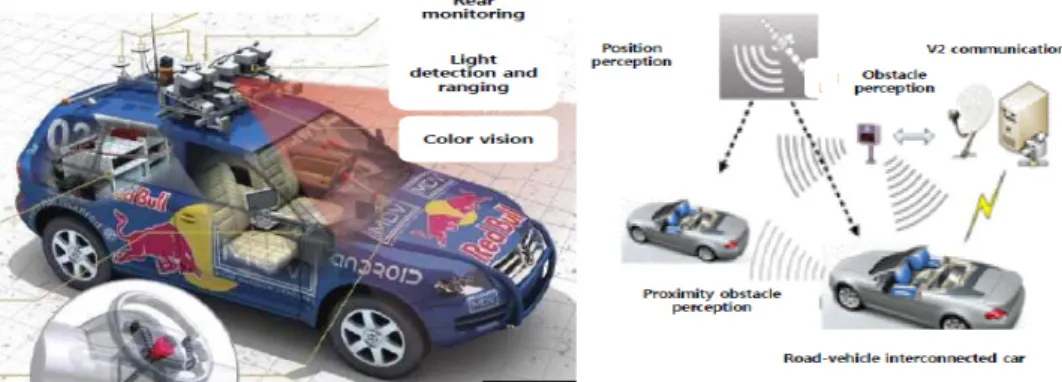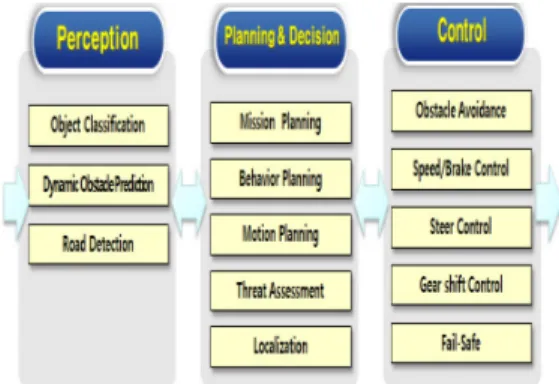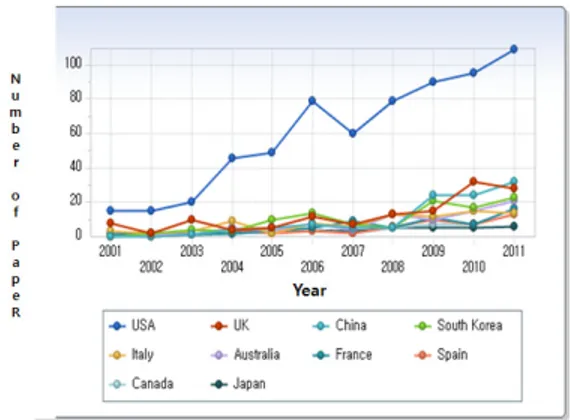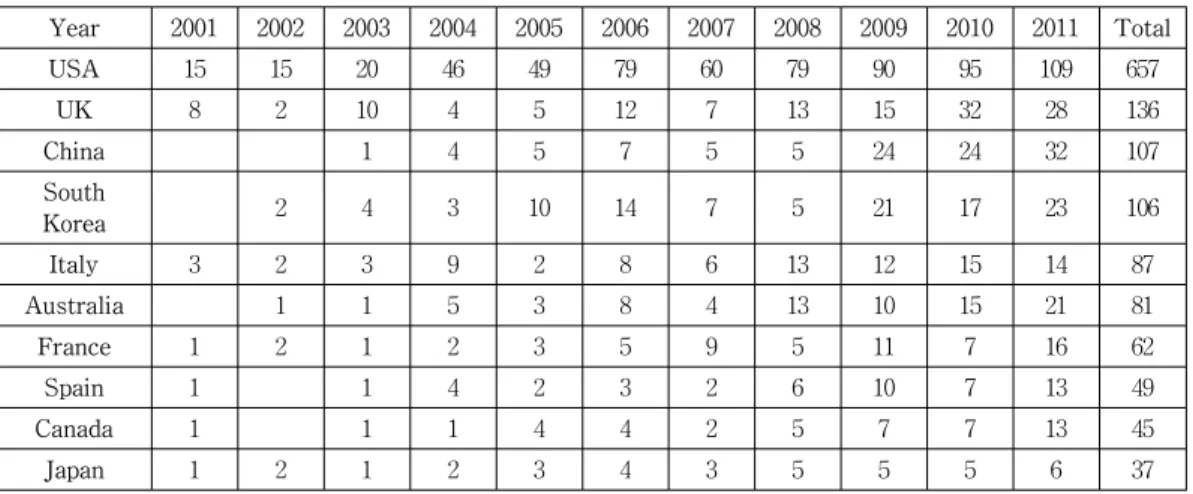국가별 논문 분석을 통한 자율주행 자동차의 계량정보 분석
박종규*․최정단******․배영철***
Scientometric Analysis of Autonomous Vehicle through Paper Analysis of each Nation
Jong-Kyu Park*․Jeong-Dan Choi**․Young-Chul Bae***
요 약
본 논문에서는 자율 주행 자동차의 연구 방향을 결정하기 위한 국가별 논문 분석을 통한 계량정보 분석을 수행한다. 이를 위해 국가별 수준 분석, 국제협력연구 네트워크 분석을 통하여 자율 주행 자동차의 연구 동향 을 확인한다.
ABSTRACT
In this paper, we review scientometric analysis through paper analysis of an each nation to decide research direction for autonomous driving vehicles. We confirms research trend of autonomous driving vehicle by using Analysis of Index Level, International Cooperation Research Network, Analysis of Key of Nations according to an each nation.
키워드
Scientometric analysis, Autonomous driving vehicle, Index level, International cooperation Research network, Analysis of key 계량정보분석, 자율 주행 자동차, 수준 분석, 국제협력연구네트워크, 핵심 분석
* 한국과학기술정보연구원(jkpark@kisti.re.kr) ** 한국전자통신연구원(jdchoi@etri.re.kr)
*** 교신저자 : 전남대학교 전기․전자통신․컴퓨터 공학부(ycbae@jnu.ac.kr)
접수일자 : 2012. 12. 10 심사(수정)일자 : 2013. 01. 15 게재확정일자 : 2013. 02. 20
Ⅰ. Introduction
Recently scientometric analysis has been widely conducted by many researchers before the start of their research. Many researchers seriously consider the novelty of their subject compared with other researchers’ subjects. Many researchers in eng- ineering or related areas have a difficult time discovering unique and reasonable research themes due to the more than two million peer-reviewed
papers published every year. Typically, due to this high volume of papers published in the research world, it is difficult to avoid redundant duplication of research subjects. Thus, in order to solve these problems, many researchers put an effort to monitor and catalog all information available using online databases. However, such a method requires enormous amounts of time and cost to acquire all necessary information from the database system.
Therefore, many researchers desire a more efficient,
Fig. 1 Concept of autonomous vehicle
(left : self-driving vehicle, right: road-infra connected vehicle)
streamlined search method for more complete lite- rature review.
To avoid duplication problem in patents, papers and research subjects, many researchers have to review previous research work and patents with various methods [1-14]. Among those methods, scientometric analysis in global dimensions has emerged as one of the best review methods for avoiding duplication in science and technology areas. However, there are very few papers applied with scientometric analysis for information retrieval.
In this paper, we review scientometric analysis for autonomous vehicles by using Analysis of Index Level, International Cooperation Research Network, Analysis of Key of Nations according to each nation. This paper is organized in four sections:
section 1 will describe why scientometric analysis is necessary in the autonomous vehicle research area, section 2 will provide definition of autonomous vehicle, section 3 will explain scientometric analysis including index level and analysis of international cooperation research network according to nation, and section 4 have a conclusion.
Ⅱ. Definition of autonomous driving vehicle
An autonomous vehicle is typically called a UGV (Unmanned Ground Vehicle), Robot or vehicle. This consists of an autonomous navigation device instead of a driver’s manipulation and fusion system, allowing IT technologies to become the eyes, hand and foot, effectively recognizing the dynamic road environment of the road to control the electric device. A fully autonomous vehicle can be con- sidered a final goal of the intelligent vehicle research area.
The intelligent safety technologies of a vehicle serve to support driving or prevent accidents.
Nowadays, development and equipment of electronic stability control of vehicles is becoming generalized.
Thus, we will expect to realize commercialization of autonomous vehicles to pursue safe and convenient means of moving through fusion of mechanical vehicle systems and IT.
Related research areas about autonomous vehicles can be contrasted based on localization and moving environment recognition systems, planning and judging systems, and vehicle systems. It is
necessary to cooperate across disciplines such as IT, mechanic engineering including robot, locali- zation and GPS, radar for obstacle recognition, information processing of various sensors including camera and ultrasonic, and communication tech- nologies with vehicle and road infrastructure.
Autonomous vehicle systems mainly divide into two categories: 1) Autonomous vehicles composed of independent systems focused into all functions of perception as shown in the left of Fig.1. 2) Road-infra connected with vehicle system creating results fused with perception results from an equipped system in the road environment or around vehicles[15]. In these systems the performance of wireless communication systems are important constitutive elements for cooperation with server systems located on the load or at the center to control the traffic flow of center.
The research of such autonomous vehicle has been processed by dividing into three grouping items largely as shown in Fig. 2.
First, perception regards methods of acquiring information for location, road geometry and still or moving objects after processing data sensed from various sensors.
The perception method uses a single or fusion of various sensors, and it is important to decide optimal situations in analogy with various results.
Fig. 2 Functional structure of autonomous driving vehicle
Perception has three major categories, including object classification, dynamic obstacle prediction, and road detection.
Second, planning and decision regards deciding and estimating the path from starting point to destination. ”Planning and Decision” has five major categories including mission planning, behavior planning, motion planning, threat assessment and localization. The mission planning estimates the path that can reach destination. The behavior planning integrates data in the stage of perception and mission planning.
The motion planning creates trajectories after planning the mission execution path. Third, Control regards how the vehicle performs the real mission to exactly follow the planned path.
Ⅲ. Information extraction from paper published in unmanned vehicle
In order to extract the information from the database, we used Web of Science (Thomson Reuters). In this paper, we try to perform the clustering method by one of three methods explained above to test which method provides the best coefficient of similarity. Moreover, we expressed cosine coefficient (Sij = Cij / SQRT(Ci * Cj) as a degree of similarity and as a crowding method which is the single linkage that links the shortest distance between two neighboring points as a hierarchal clustering method. We also per- formed the clustering method at maximum and minimum sized clusters that is 50 and 5, respectively, and chose the optimal value at a threshold between 0.1-0.3.
We search a paper on unmanned vehicles in the Web of Science using equation (1) as the following as.
Topic="(unmanned)” AND Topic=”(vehicle*”) (1) From equation (1) we restrict search years
between 2000-2011 and also restrict the language to English. The explained conditions yielded a total of 1,592 papers.
To calculate an average annual increase of unmanned vehicle papers, we use equation (2) as follows:[5]
× (2)
Where, is
From the equation (2), we get 22.93% as an average increase annual rate and 44.18% as reference of an accumulated increase rate for unmanned vehicle papers. Table 1 shows number of papers, accumulated number of papers and number of papers by Korean authors from 2001 to 2011 for unmanned vehicles.
Fig. 3 shows the trend of number of published papers in the world and Korean author like Table 1. The bar graph and polygonal line display the number of total papers published in the world and the number of papers published by a Korean author, respectively.
Table 1. The number of published papers
Year NP* NAP* NKAP*
2001 41 41
2002 33 74 2
2003 54 128 4
2004 84 212 3
2005 96 308 10
2006 167 475 14
2007 119 594 7
2008 171 765 5
2009 239 1,004 21
2010 265 1,269 17
2011 323 1,592 23
* NP : Number of papers
* NAP : Number of accumulated papers
* NKAP : Number of Korean author’s papers
Fig. 3 Trend of number of published papers in the world and Korean author on autonomous vehicles.
Ⅳ. Scientometric Analysis through Index Level at each Nation for Autonomous
driving Vehicle
4.1 Analysis of index level[5]
In order to analyze the index level of scientom- etric analysis for unmanned vehicle using published papers, we have to define the index level. In this paper, we used three index levels including countries, organizations, and authors. Generally, in- dex levels can be defined by equation (3) for countries, organizations, and authors.
(3)
Where, Q means index level and infix c,o and ,a are country (c), organization (o) and author (a) respectively. M is the number of average citations for the total papers published in certain technical area.
are the number of average cited published papers of certain country (c), organization (o) and author (a), respectively.
Equation (3) means qualitative level evaluation index based on the number of citrated papers. For example, if we calculate the index level of countries, organizations and authors by using equation (3), we can describe the equation (3) as a and ,
respectively. If index level and are equal to 1.0, it means that number of average cited papers in certain countries, organizations and authors is equal to number of average total cited papers published in related subject area. If the index level is over 1.0, it means that the numbers of average cited paper in certain countries, organizations and authors are higher than the number of average cited paper published in the certain area.
4.2 Analysis of each country
4.2.1 Number of papers of each country
As a result of analysis for author’s nationality of published paper in Web of Science for unmanned vehicle during 2001-2011, this subject has been performed by 56 countries through the world.
During these periods the total number of published papers is 1,592 and USA has been the largest published 657 and account 41.27 percent among these countries. The second and third largest published nations are UK and China, its countries has been published 135 papers, 8.54% and 107 papers, 6.72%, respectively.
Table 2 shows distribution of each country for published papers during 2001-2011.
Table 2. Distribution of each country for published papers.
Ranking Nation NP* Ratio(%)
1 USA 657 41.27
2 UK 136 8.54
3 China 107 6.72
4 South Korea 106 6.66
5 Italy 87 5.46
6 Australia 81 5.09
7 France 62 3.89
8 Spain 49 3.08
9 Canada 45 2.83
10 Japan 37 2.32
* NP : Number of papers
4.2.2 Number of papers of the time in years Table 3 and Fig. 4 show the number of published papers of each country and year during 2001-2011, respectively.
Fig. 4 Trend of number of published papers of each country during 2001-2011.
4.2.3 Analysis of index level for each country We calculate index level for each country by using equation (3). Table 4 and Figure 5 show the index level of published for each country respectively. As a result of analysis of index level for each country from Table 4 and Fig.5, we can see the Spain has the highest value as 1.643. It means the level of qualities of papers is high compared with other countries as view point of citation of papers. Several countries including France (2.367), Germany (2.214), USA (1.834), UK (1.49), Japan (1.15), Italy (1.075) displays index level above average.
The index level of Republic of Korea records 0.555 which is below average.
Several countries including Spain (1.643), France (1.588), USA (1.437), Japan (1.088), and Australia (1.031) displays index level above average. The index level of Republic of Korea records 0.559 which it means below average about quality level of papers through the world compare to other countries.
Table 3. Trend of the number of published papers of each country and year during
Year 2001 2002 2003 2004 2005 2006 2007 2008 2009 2010 2011 Total
USA 15 15 20 46 49 79 60 79 90 95 109 657
UK 8 2 10 4 5 12 7 13 15 32 28 136
China 1 4 5 7 5 5 24 24 32 107
South
Korea 2 4 3 10 14 7 5 21 17 23 106
Italy 3 2 3 9 2 8 6 13 12 15 14 87
Australia 1 1 5 3 8 4 13 10 15 21 81
France 1 2 1 2 3 5 9 5 11 7 16 62
Spain 1 1 4 2 3 2 6 10 7 13 49
Canada 1 1 1 4 4 2 5 7 7 13 45
Japan 1 2 1 2 3 4 3 5 5 5 6 37
3.2.4 Analysis of international cooperation rese- arch network for each country
In order to study International Cooperation Res- earch Relationship, we investigate International Cooperation Research Network between countries and Relationship index of international coop- eration(S) and Intensity of International Cooperation (L) in each nation. Fig. 6 shows international cooperation research network for each country.
Table 4. Index level of each country papers published during 2001-2011
Nation NP* IP* IL*
Spain 49 7.592 1.643
France 62 7.339 1.588
USA 657 6.641 1.437
Japan 37 5.027 1.088
Australia 81 4.765 1.031
Canada 45 4.444 0.962
Italy 87 4.276 0.925
UK 136 3.61 0.781
South Korea 106 2.585 0.559
China 107 2.262 0.489
* NP : Number of papers
* IP : Impact factor, * IL: Index level
Fig. 5 Index level of each country papers published 2001-2011
Fig. 6 Index level versus number of papers of each country in autonomous vehicle
Ⅴ. Conclusion
In this paper, we presented scientometric analysis including analysis of Index Level and International Cooperation Research Network for autonomous vehicle. Through this presented method, we can review research areas for autonomous vehicle that previously done to avoid possible duplication problem in papers.
By using reviewed method, it is possible to avoid any potential for duplicating published papers and find new research area. In the future, more research is necessary to improve the results about scientometric analysis for organization and author.
Ⅵ. Acknowledgements
The analysis in this research was carried out by using the on-line information analysis system, COMPAS (COMPetitive Analysis Service), deve- loped by the Division of Information Analysis, Korea Institute of Science and Technology Info- rmation.
REFERENCE
[1] The methodology of patent analysis to write the technical road map, MCIE(Ministry of Commerce, Industry and Energy) and KOTEF, 2006.
[2] H. Ernst, "Evaluation of Dynamical Techn- ological Developments by means of Patent data", Springer, New York, 1999.
[3] H. Ernst, " Patent portfolios for strategics R&D planning", Journal of Engineering and Technology Management, Vol. 15, pp. 279-308, 1998.
[4] Jong-Kyu Park,.Young-Chul Bae, "Develo- pment of a Technical Road Map for Future Research in Wind Power Generation using Grading Criteria as a Rubric for Research Focus", The Journal of The Korea Institute of
Electronic Communication Science, Vol. 6, No.
3, pp. 417-423, 2011.
[5] Jong-Kyu Park,.Young-Chul Bae, “Scientometric Analysis for Pilot Study of Smart Grid”, The Journal of The Korea Institute of Electronic Communication Science, Vol. 7, No. 1, pp.
97-105, 2012.
[6] Young-Duk Koo, Young-IL Kwon, Dae-Hyun Jeong, “Analysis of a Technical Competition based on Intellectual Property for Constitute of LED Knowledge Map”, The Journal of The Korea Institute of Electronic Communication Science, Vol. 7, No. 5, pp. 955-960, 2012.
[7] Young-Duk Koo, Dae-Hyun Jeong, Young-IL Kwon, “LED Knowledge Map through a Patent Application”, The Journal of The Korea Institute of Electronic Communication Science, Vol. 7, No. 5, pp. 961-966, 2012.
[8] Se-Jung Ahn, We Shim, June-Young Lee, Oh-Jin Kwon, Kyung-Ran Noh, “Trends Det- ection of Display Research Areas by Bibl- iometric Analysis”, The Journal of The Korea Institute of Electronic Communication Science, Vol. 7, No. 6, pp. 1343-1351, 2012.
[9] June-Young Lee, We Shim, Se-Jung Ahn, Oh-Jin Kwon, Kyung-Ran Noh,, “A Study on the Citation Impact of International Collaboration Research for 13 Government-supported Research Institutes of Korea Research Council of Funda- mental Science and Technology(KRCF)”, The Journal of The Korea Institute of Electronic Communication Science, Vol. 7, No. 6, pp.
1353-1362, 2012.
[10] Se-Jung Ahn, Do-Hyun Kim, Oh-Jin Kwon, Young-Chul Bae, June-Young Lee, “Analysis on the Dynamics of Keyword Mapping for Detecting Emerging Technologies : A Case Study on Graphene“, The Journal of The Korea Institute of Electronic Communication Science, Vol. 7, No. 6, pp. 1393-1401, 2012.
[11] Sang-Yun Lee,Hong-Joo Yoon, “Korea's Global Science & Technology(S&T) Agenda”, The Journal of The Korea Institute of Electronic Communication Science, Vol. 7, No. 4, pp.
693-705, 2012.
[12] Sang-Yun Lee,Hong-Joo Yoon, “The Study on Development of Technology for Electronic Government of S. Korea with Cloud Com-
puting analysed by the Application of Sce- nario Planning”, The Journal of The Korea Institute of Electronic Communication Science, Vol. 7, No. 6, pp. 1245-1258, 2012.
[13] Sang-Yun Lee,Hong-Joo Yoon, “The Study on Strategy of National Information for Electronic Government of S. Korea with Public Data analysed by the Application of Scenario Planning”, The Journal of The Korea Institute of Electronic Communication Science, Vol. 7, No. 6, pp. 1259-1273, 2012.
[14] Sang-Yun Lee,Hong-Joo Yoon, “The Study of SWOT(Strength –Weakness- Opportunity- Th- reat) Analysis for Micro-robot”, The Journal of The Korea Institute of Electronic Commu- nication Science, Vol. 7, No. 4, pp. 881-895, 2012.
[15] Jeong-Dan Choi, Kyung-Wook Min, “Guidance protocol via personal ITS station for advisory safety information”, IEEE ICCE2013, pp. 659- 660, 2013.
저자 소개
박종규(Jong-Kyu Park)
1984년 2월 중앙대학교 전자공학과 (공학사)
1990년 2월 중앙대학교 전자공학과 (공학석사)
1991년~현재 : 한국과학기술정보연구원 선임연구원
※ 관심분야 : 로봇 제어, 모터 제어, 산업통신망
최정단(Jeong-Dan Choi)
1993년 2월 중앙대학교 전자계산학과 (공학사)
1995년 2월 중앙대학교 컴퓨터공학과 (공학석사)
2005년 2월 충남대학교 전산학(이학박사) 1995년~현재 : 한국전자통신연구원 책임연구원
※ 관심분야 : 영상처리 및 컴퓨터그래픽스, 자동차-IT, 텔레매틱스, ITS
배영철(Young-Chul Bae)
1984년 광운대학교 전기공학과(공 학사)
1986년 광운대학교대학원 전기공학과 (공학석사)
1997년 광운대학교대학원 전기공학과(공학박사) 1986년~1991년 한국전력공사
1991년~1997년 산업기술정보원 책임연구원
1997년~2006년 여수대학교 전자통신전기공학부 부교수 2002년~2002년 Brigham Young University 방문교수 2006년~현재 전남대학교 전기․전자통신․컴퓨터공학부 교수
2011년~2011년 University of Utah 방문교수
※ 관심분야 : Chaos Control and Chaos Robot, Robot control etc.




